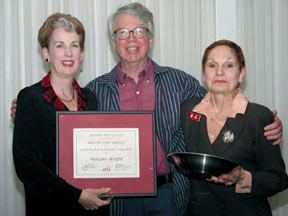
|
malcolm wright portfolio catalogues news & events the kiln contact us |
|
WALTER CERF LIFETIME ACHIEVEMENT AWARD from the Vermont Arts Council for Malcolm Wright, June 13, 2003. presented by Anne Wollman Felicitous matches are often made by chance. After the builder of our home in Woodstock, Vt had seen our ceramic collection, he told us about his cousin, Malcolm Wright, who made ceramics and lived in Marlboro, Vt. But he said he had no idea of the type of work, the quality, or the stature of the artist. Always curious and enjoying meeting artists, I called and arranged to visit The Turnpike Road Pottery which is open most everyday for serious visitors. What I found was a charming, humble man, an intellectual who is not only passionate about ceramics, but also art history, painting, architecture, design theory and music, in a word, all the arts. And the spacious studio revealed extraordinary work that had unfortunately been missing from my ceramic experience, but that had been recognized and lauded for years by potters, scholars, collectors, museums and galleries around the world. Malcolm came to Vermont from just west of Lake Wobegone in Minnesota to attend the Woodstock Country School and the Marlboro College. He still feels very much a part of the Marlboro College community as he founded its ceramic program and guided it for ten years. Coincidentally, Louis Moyse who was also presented with a Lifetime Achievement Award on this same night, was his beloved music professor. Malcolm and his wife, Marge are still avid supporters of chamber music and the Marlboro Music Festival, as well as the Vermont Symphony Orchestra. While at Marlboro College in the early 60s, Malcolm met many distinguished potters at the New Hampshire League of Craftsmen and worked with several to learn the art of making and selling pots. His interest in ceramics was nurtured by an aunt who was a studio potter, and encouraged by his father who understood Malcolm's attraction to the lifestyle of the potter and its relationship to the land. Not unlike the farmer's situation, Malcolm's living is made from and on his land and the family can share the daily chores and see the immediate products of his work. This tenet is the force behind the Arts and Crafts movement popular at the beginning of the 20th century and still espoused by artists and collectors who prize the hand-made object over the industrial. Enrolling in the combined MFA ceramics program at George Washington University and The Corcoran Gallery of Art, Malcolm was introduced to the work of his Japanese teacher, Teruo Hara, who was a great source of inspiration. Shortly after graduation, Malcolm, Marge and their infant son headed to Kyoto where Malcolm studied Japanese and traditional ceramic glazing. The real challenge came when he began to apprentice in Karatsu on the island of Kyushu with Tarouemon Nakazato, XII, a 12th generation potter and a Living National Treasure. The job consisted of the most menial tasks such as sweeping, cleaning, digging clay and firing the kiln a labor intensive, time-consuming process with the added discomfort of high levels of heat. After eight months, an apprentice was expected to produce traditional Karatsu shapes by examining old angled shards and attempting to throw on the wheel the original rounded shapes from which these shards had been made. It was this trial and error, extremely disciplined method that Malcolm believes provided him with a focus and a willingness to experiment. Malcolm says of the experience, "I would line up with other workers, bow and promise to work that day as hard as I had the day before. I was expected to respond just as a Japanese apprentice would to every situation, and I did, except once when the eldest son asked me if I wanted to have an exhibition of my work in Japan and I said, 'Yes,' (the American response) because I knew I would not be asked again for six months. The proper answer would have been to say 'no' until the third time one is asked." The affirmative response resulted in his first show in Japan. Returning to the land he purchased in Marlboro, VT, Malcolm began to build a wood-burning, three-chambered kiln, similar to the one he used in Karatsu. It is 21 feet long, 6 feet wide, and sits several hundred yards from the home he designed. The gas kiln is in the studio and is used for biscuiting and firing glazed oven and dinnerware. The wood kiln is used for firing brick clay and unglazed work. In this 24-hour process, wood ash and fire combine to create the finished piece and all personal control and attention lavished on the piece earlier are at the mercy of the fire. As Malcolm says, "The joy is giving up control to the kiln and allowing the piece to become itself." Products of these two kilns are what I discovered on my first visit to the pottery. From the gas kiln I saw wonderful dinner and oven ware, glazed with mellow tones of honey, orange and celadon, and decorated with swirls that look like abstract flowers or birds. Sculptural, angled forms, many created with an extruder (one of Malcolm's favorite tools) and fired with wood to create a broad palette of rich brown and red surfaces, caught my eye. Pots with heavy ash deposit had bold, 3-dimensional textures, suggesting that the action of the fire and wood in the kiln had never stopped. Shapes that were hard to the touch, but seemed as soft to the eye as a folded linen napkin, functioned as exquisite vases. A soft neck connected to an oval head reminded one of Brancusi's sculptures and the minimalism that often inspires Malcolm. One of Malcolm's most recent monumental pieces is a cube cut in half which reveals the positive mass of the curve of the lower back on one half and its negative space on the other half, similar to bookends which together make up a single cube. Scholars have written about the juxtaposition of mass and void in Malcolm's work and how it relates to the human body, as well as its relation to the mass and void created by shadows and paint on buildings in Italian hill towns. Malcolm acknowledges the latter as a result of his study of Italian painting and architecture. He considers his work eclectic, citing not only Japanese, Chinese, Korean and English sources, but artists, such as painter Richard Diebenkorn and sculptor, Tony Smith, as well. By sharing his creative expertise and kiln facilities with may local potters and by attracting many to Vermont to enjoy, study, and collect his work, Malcolm has contributed to Vermont's prestige in the arts. He has served on many Vermont art boards and had fostered the creative and economic development of crafts around New England through his leadership of the Craft Professionals, a precursor of the Vermont Craft Council. His international contributions include inviting Japanese potters to apprentice with him providing a stimulating interactive experience for all. More recently, (1991) he and Takashi Nakazato, the son of his mentor, conceived a plan to work in each other's studios January and July in Vermont, and May and June in Karatsu. The collaboration produced a body of work shown at the Springfield Museum in Massachusetts, and a stunning catalogue entitled "Bridge of Fire." Currently, Nakazato's daughter, Hanako, is working with Malcolm as an associate, making her own work, sharing chores and the studio. Eventually, Malcolm will leave the studio and kiln to her. The museums, national and international which hold Malcolm's work, the publications in which scholars have acknowledged his contributions, and the awards which he has received, are numerous. I am so lucky to know him, to enjoy his work everyday and thrilled to be able to give him today, the Walter Cerf Lifetime Achievement Award from the Vermont Arts Council.
|
||||
| home | contact us | malcolm wright | portfolio | news & events | kiln | catalogues | glaze formulas |
copyright © 2025 turnpike road pottery site design: eismontdesign
